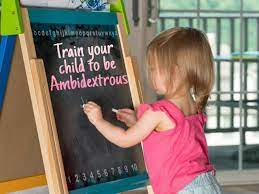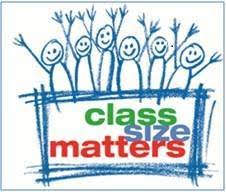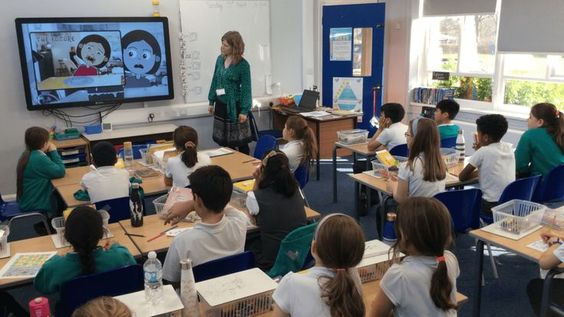The phenomenon of ambidexterity, or the ability to use both the left and right hands with equal proficiency, is a unique trait found in a small portion of the population. In a classroom setting, catering to the needs of ambidextrous kids can pose a unique set of challenges and opportunities for educators. With tailored strategies that understand and nurture this ability, teachers can greatly enhance the learning experience for ambidextrous students.
Understanding Ambidexterity in Children
Ambidexterity manifests itself in different ways. Some children have no dominant hand and switch between using their left and right hands effortlessly. Others prefer one hand for certain tasks and the other hand for different activities. Recognizing these patterns is vital to providing appropriate support in the classroom.
Benefits of Ambidexterity
Children who are ambidextrous can benefit from their versatility in various ways:
Improved motor skills: The use of both hands develops fine motor skills and coordination.
Enhanced brain development: Ambidexterity is believed to be associated with connecting both hemispheres of the brain, potentially leading to creative problem-solving skills.
Flexibility: Ambidextrous individuals can adjust to situations where a dominant hand might be at a disadvantage.
Classroom Strategies for Ambidextrous Kids
Here are several strategies that educators can employ to support ambidextrous children:
Provide ambidextrous tools: Offer scissors, rulers, and other supplies that are designed for use with either hand.
Flexible seating arrangements: Position desks and workspaces to allow freedom of movement for both arms.
Writing implements: Stock pencils, pens, and markers that are comfortable for all students to grip, regardless of which hand they use.
Encourage experimentation: Allow children to try using both hands during different activities to find what feels most natural for them.
Normalize ambidexterity: Incorporate discussions about famous ambidextrous people and emphasize that this trait is simply another form of diversity.
Avoid forced hand dominance: Do not pressure children to choose one hand over another. Let their preference develop naturally.
Tailored instruction: Provide additional guidance for ambidextrous students during activities traditionally designed with right-handed individuals in mind, such as handwriting.
Praise flexibility: Celebrate the ability of these students to adapt to different tasks using either hand.
Adjusting Assessment Methods
Assessments should be mindful of an ambidextrous child’s unique needs. For instance:
Avoid timed tests that could disadvantage those not using their dominant hand out of choice or necessity.
Consider oral assessments or alternative demonstration methods if handwriting speed is an issue.
Monitor both gross and fine motor skill development across both hands.
Challenges Faced by Ambidextrous Kids
Children who are ambidextrous may face specific challenges:
Confusion or inconsistency in choosing which hand to use for certain tasks may lead to slower skill acquisition temporarily.
There may be societal or cultural pressures favoring right-handedness that can affect self-esteem.
Some may experience difficulty with writing as they may smudge ink more easily when switching hands or due to adopting unusual hand positions.
Support Networks
Creating a support network including teachers, parents, occupational therapists, and even older students who are ambidextrous can provide not only practical support but also reinforce positive self-image and problem-solving strategies.
Conclusion
Inclusive education requires attention to all aspects of diversity, including dexterity. By recognizing and nurturing the abilities of ambidextrous kids in the classroom, educators can foster an environment where every student has the opportunity to excel without barriers. Innovative teaching methods that accommodate this special form of dexterity can make a significant difference in a child’s educational journey.
Mentor Teacher: Why You Need One and How to Find Them
The teaching profession, like any other skilled career, requires continuous growth and development. One of the most valuable resources for personal and professional advancement in education is a mentor teacher. But why do you need one, and how can you find the right match? Let’s dive in.
Why You Need a Mentor Teacher:
1. Guidance: As a novice in the educational field, it is easy to feel overwhelmed. A mentor teacher has walked the path before you and can offer actionable advice to navigate teaching complexities.
2. Professional Development: Mentor teachers often help in identifying areas for growth, suggesting relevant training or workshops, and providing opportunities for co-teaching or observation.
3. Networking: Having an experienced mentor means you have an advocate who can introduce you to education professionals, which can lead to collaborative projects and job opportunities.
4. Emotional Support: Teaching is emotionally demanding. A mentor understands the unique pressures of the job and can provide emotional support and strategies to maintain well-being.
5. Feedback: Constructive feedback from a trusted mentor is invaluable for improving teaching practices. A mentor’s perspective can help fine-tune lesson delivery, classroom management, and student engagement techniques.
How to Find a Mentor Teacher:
1. Identify Your Needs: Understand what kind of support you are looking for—whether it is subject-specific knowledge, classroom management skills, or career guidance.
2. Utilize School Resources: Inquire about formal mentoring programs within your school district or institution that pair veteran teachers with new educators.
3. Explore Professional Organizations: Many educational organizations have mentoring programs—joining these can connect you with potential mentors.
4. Ask Directly: If there’s a teacher whose work you admire within your network, approach them directly about the possibility of becoming your mentor.
5. Leverage Social Media: Professional platforms like LinkedIn or Twitter can be instrumental in connecting educators across the globe—reach out to potential mentors online.
6. Attend Professional Development Sessions: These sessions are excellent places to meet potential mentors who are interested in supporting colleagues.
In conclusion, finding a mentor teacher can significantly impact your educational career trajectories positively by shaping your professional identity, refining your pedagogy, and expanding your professional network. Start exploring your options today!
Class Size Matter Teachers Point View
Class size has long been a topic of debate in educational circles, with opinions ranging from administrators to teachers, parents, and educational researchers. When considering the perspective of teachers, class size is often seen as a critical factor that can influence the quality of teaching and learning.
From the standpoint of educators, smaller class sizes are generally preferred. This preference stems from the belief that with fewer students to manage, teachers can provide more personalized attention to each student. The benefits of small classes are numerous; they include increased student engagement, better classroom management, enhanced student-teacher relationships, and more opportunities for individualized instruction.
Teachers often report that with smaller classes, they can tailor their teaching methods to meet the varied learning styles and needs of their students. This customization is crucial for addressing different levels of ability within a classroom and providing support where necessary. Moreover, it allows for more effective monitoring of student progress and quicker identification of those who may be falling behind.
In contrast, large class sizes can make it challenging for teachers to maintain control and manage classroom dynamics effectively. Discipline issues may arise due to the sheer number of students and the reduced capacity for teachers to give undivided attention when conflicts or problems occur. The workload associated with large classes is another concern for teachers; these classes require more time for grading assignments, planning lessons suitable for a wide range of learners, and attending to administrative tasks.
Furthermore, teachers argue that in large classes, students are less likely to participate in discussions or ask questions due to fear or anxiety about speaking up in front of many peers. This reduction in participation can hinder the development of critical thinking skills and diminish the richness of classroom discourse.
In conclusion, from a teacher’s point of view, class size does matter greatly. Smaller classes often create an environment that fosters learning by allowing for individualized attention, reducing stress on teachers’ workloads, and promoting an atmosphere where students feel comfortable engaging with material. While it is not always feasible financially or logistically to reduce class sizes significantly, understanding its importance could help school districts and policymakers make informed decisions that prioritize teacher effectiveness and student learning outcomes.
10 Books That Will Help You Build a Positive School Culture
Introduction:
Building a positive school culture is crucial for fostering academic achievement, enhanced mental health, and increased teacher and student satisfaction. An effective way to improve the atmosphere in your educational institution is by gaining insights from experts in the field. Here is a list of ten incredible books that offer transformative strategies to help you create a thriving school environment.
1. “The Power of a Positive Team” by Jon Gordon
In this book, author Jon Gordon explores the intricacies of teamwork and offers practical techniques for creating an environment of positivity, collaboration, and success in the school setting.
2. “Better Than Carrots or Sticks: Restorative Practices for Positive Classroom Management” by Dominique Smith, Douglas Fisher, and Nancy Frey
This book advocates for restorative practices as an alternative to traditional punitive disciplinary measures. The authors provide concrete strategies to help educators develop a culture of accountability, responsibility, and mutual respect within the classroom.
3. “Creating Emotionally Safe Schools: A Guide for Educators and Parents” by Jane Bluestein
This guide emphasizes the importance of emotional safety and its role in creating a positive school culture. Bluestein equips educators with practical tools to cultivate an atmosphere that supports students’ social and emotional growth.
4. “The Culturally Responsive Classroom: Connecting Culture to Student Achievement” by Bonnie M. Davis
Appreciating diversity is essential in building a positive school culture. In this book, Davis provides a framework that aligns teaching methods with the cultural needs of students to enhance their learning experiences and promote academic success.
5. “School Climate Change: How Do I Build a Positive Environment for Learning?” by Peter DeWitt
DeWitt outlines practical steps in transforming the school climate into one that acknowledges individual needs while fostering collaboration between educators, students, and parents.
6. “The New Principal’s Fieldbook: Strategies for Success” by Pamela Robbins and Harvey Alvy
Geared towards both new and experienced school administrators, this book offers insights to improve school culture, boost teacher morale, and focus on continuous growth.
7. “Reclaiming Our Teaching Profession: The Power of Educators to Transform Schools” by Shirley Hord and Edith Rushton
In this inspiring read, Hord and Rushton promote the value of every educator in contributing to positive change within schools, igniting a passion for teaching and improving the overall environment.
8. “The Positive Dog: A Story About the Power of Positivity” by Jon Gordon
Through an engaging story, Gordon teaches readers how adopting a positive mindset can influence all aspects of life – including education. Implementing such an outlook can deeply impact school culture and student outcomes.
9. “Activate: A Leader’s Guide to People, Practices, and Performance” by Deanna Burney
Burney shares her proven approach to transforming underperforming schools into thriving educational institutions. This guide is a valuable resource for educators seeking real-world examples of successful strategies in improving school culture.
10. “Mindset: The New Psychology of Success” by Carol Dweck
Renowned psychologist Carol Dweck introduces the groundbreaking concept of fixed vs. growth mindsets and demonstrates how embracing a growth mindset can lead to success within schools and beyond.
Conclusion:
Investing time in reading these insightful books can help you build a school culture that values every individual, enhances academic performance, fosters emotional security, and promotes lifelong learning. By implementing their recommendations, you can create a positive atmosphere that will benefit not just your students but also faculty, staff, parents, and the community at large.
Instead of Shaming Teachers, We Should Be Empowering Them to Disrupt the System
Introduction:
It is no secret that teachers play a pivotal role in shaping the minds of future generations. Yet, time and again, we see them being criticized, underappreciated, and underpaid for their efforts. This must change. Instead of shaming teachers, society must focus on empowering them to disrupt the conventional educational system for the betterment of our collective future.
Shaming Teachers Creates a Toxic Atmosphere
The widespread practice of shaming and blaming teachers serves only to create a toxic environment that stifles innovation and empowerment. Teachers, like anyone else, need support, encouragement, and constructive feedback in order to grow professionally. If we continue to shame them for issues that are often out of their control – such as budget cuts, overcrowded classrooms, and systemic barriers – we will simply hinder progress and perpetuate a failing system.
Empowering Teachers as Change Agents
Empowering teachers means providing them with the resources and opportunities they need to innovate and disrupt the status quo. It involves nurturing their creativity so they can develop effective teaching strategies tailored to their unique classrooms.
1. Increased Compensation: Paying teachers what they are truly worth is essential in order to attract the best talent to education. This could potentially lead to more passionate educators who are dedicated to creating lasting change in their profession.
2. Professional Development Opportunities: Encouraging teachers to engage in continuous learning through conferences, workshops, and research opportunities helps build up not just individual skill sets but also a collective understanding of new educational methodologies.
3. Collaborative Work Environments: Promoting collaboration among teachers enables them to learn from one another’s experiences while building supportive relationships in an often isolating profession. Removing competition will allow teachers to leverage each other’s strengths.
4. Autonomy in Teaching Approaches: Trusting educators with greater autonomy in deciding how best to teach their students can unleash their creativity and ability to craft lessons based on the needs of their specific classrooms.
5. Parent and Community Support: Engaging parents and communities in the educational process fosters a sense of shared responsibility, breaking down the barriers that often exist between schools and the communities they serve.
With these foundations in place, teachers will be far better equipped to challenge conventional wisdom, enact real change, and lead a revolution in education.
Conclusion:
Teachers are integral to shaping our future generations, and it is high time we start treating them as such. Shaming them undermines their ability to thrive in their profession and stifles any meaningful progress in education. By providing teachers with the resources, respect, and autonomy they deserve, we can empower them to be bold agents of change and actively disrupt the status quo of our educational system. This approach will ultimately lead to better outcomes – not just for students, but for society as a whole.
We’re Talking About the Wrong Education Gap
Introduction:
The education gap is a term regularly discussed in political and educational settings. While most people refer to the achievement gap based on socioeconomic, ethnic, and other factors that influence access to quality education, the discussion has largely overlooked a vital aspect of the problem. This article shifts the focus to explore this often-neglected dimension of educational disparity and explains why acknowledging and addressing it is crucial.
Misguided Conversations Surrounding the Education Gap:
Education policies and programs are frequently designed to target achievement gaps between high-achieving and low-achieving students. These differences usually stem from socioeconomic factors or geographic location that either provide access to more educational resources or hinder it. However, a more nuanced conversation is needed for policymakers and educators to understand that there is more lurking in the shadow of these disparities than meets the eye.
The Bigger Picture: The Skills Gap
One significant area that deserves our attention is the “skills gap.” The skills gap refers to the disconnect between what students learn in school and what employers demand in terms of skills for available jobs. It’s essential to recognize that bridging this gap contributes significantly towards reducing unemployment or underemployment rates while bolstering economic growth.
Causes of the Skills Gap:
A few factors contribute to this gap:
1. Education System – Traditional education systems may not update curriculum in sync with industry demands, leaving students ill-prepared for the job market.
2. Lack of Vocational Training – Limited access to vocational training translates into fewer students who have skills relevant to specific industries.
3. Misalignment between Employers and Educators – Poor communication between employers and educators can lead to mismatches in skill sets being taught versus what industries require.
Tackling this crucial issue requires a collective effort from various stakeholders – students, parents, educators, policymakers, and employers alike.
Potential Solutions for Bridging the Skills Gap:
Implementing the following strategies can help in narrowing the skills gap:
1. Encourage Public-Private Partnerships – Engaging stakeholders from both educational institutions and industries can help in updating the curriculum and implementing practical training effectively.
2. Boost Vocational Education – Increasing access to vocational training programs, apprenticeships, and internships provides hands-on industry experience and focuses on developing specific skill sets.
3. Implement Soft Skills Training – Integrating soft skills training within the education system can prepare students for the challenges they’ll encounter in their careers.
4. Continuous Learning Initiatives – Promoting a culture of continuous learning, upskilling, and professional development can keep students and employees in tune with evolving industry demands.
Conclusion:
The current discussions revolving around the education gap are overly focused on traditional factors such as income, race, and neighborhood characteristics. We need to shift our conversations to include the more pressing issue of the skills gap and actively work towards targeted solutions that will benefit both students and employers in the long run. By identifying and addressing these gaps more holistically, we can better match talent with opportunity to create a stronger, more resilient workforce ready to meet ever-changing industry demands.
Ebac Humanities: A Savior Or A Curse?
Introduction:
In today’s fast-paced world, the integration of technology and artificial intelligence in various aspects of our lives has brought numerous benefits. Among these innovations is the use of AI writing systems, such as Ebac Humanities. As with any technological advancement, opinions vary when it comes to the usefulness and ethical implications associated with this system. This article will discuss Ebac Humanities and assess whether it is a savior or a curse.
What is Ebac Humanities?
Ebac Humanities is an AI-powered writing system designed to assist users in generating high-quality content across various fields, such as academic research, journalism, marketing, politics, and literature. This cutting-edge technology uses natural language processing (NLP) and machine learning algorithms to comprehend complex topics and produce coherent, engaging content that aligns with the user’s intentions.
The Savior Side:
1. Saves Time: AI-driven writing systems like Ebac Humanities can significantly cut down the time spent brainstorming ideas or researching information. These systems can process vast amounts of data quickly without losing track of context and intricate subject matters.
2. Enhances Creativity: Contrary to popular belief, AI writing systems may enhance human creativity by providing unique perspectives on familiar subjects. Machine learning models are capable of generating innovative ideas that humans might not have considered before.
3. Democratizes Content Creation: By producing meaningful articles within minutes, less experienced writers or non-writers can easily generate professional-level content. It can help convert creative ideas from people without strong writing skills into engaging pieces.
The Curse Side:
1. Erosion of Creativity: Some argue that a reliance on AI-generated content could lead to an erosion of human creativity in the long run. Writers might feel threatened or discouraged from putting in their best work when machines can generate similar content at a much faster rate.
2. Job Losses: Although its effect on job losses in the writing industry is still debatable, critics argue that it could contribute to unemployment. If machines continue to outperform humans in content creation, companies might prefer AI-powered writing systems over human writers to cut down costs and increase efficiency.
3. Plagiarism: Some AI-generated content may be flagged for similarity or plagiarism issues, particularly if not cited or attributed appropriately. While AI platforms have algorithms designed to avoid plagiarism, instances of accidental overlap with existing content due to vast data training sets can occur.
Conclusion:
Ebac Humanities, like any other AI-powered writing system, has its pros and cons. It can save time, enhance creativity, and democratize content creation but at the same time may have consequences like eroding creativity, jeopardizing job security, and raising plagiarism concerns. Individual users should carefully weigh these factors before deciding whether to adopt these technologies into their writing processes. Integration of AI in the field of writing should always be viewed as an enhancement of human capability rather than a replacement for it.
The progress of PSHE
In recent years, the importance of Personal, Social, Health, and Economic (PSHE) education has been recognized across the globe for its role in fostering holistic development among children and young adults. As a subject that focuses on the mental, emotional, and physical well-being of students while equipping them with essential life skills, PSHE has made significant strides in being incorporated into educational curricula.
A Shift in Educational Priorities
Traditionally, schooling systems had focused primarily on academic achievements and intellectual development. However, there has been a growing interest in prioritizing students’ mental health and personal development. The incorporation of PSHE into mainstream education indicates a more comprehensive understanding of learning that goes beyond the boundaries of conventional subjects.
Expansive Subject Matter
One major progress in PSHE is the broadening scope of topics covered within its curriculum. Initially limited to areas like relationships and sex education or drug awareness, today’s PSHE lessons address a wide range of issues. These include mental health, well-being practices, financial literacy, online safety, career guidance, environmental stewardship, and human rights among others.
An Emphasis on Mental Health
The World Health Organization (WHO) has highlighted that mental health is an integral part of public health policy and deserves due attention. In response to the growing mental health crisis worldwide, PSHE curricula now incorporate dedicated lessons to help students identify symptoms of common mental health issues and guide them towards appropriate support channels.
Inclusivity at its Core
With societies becoming increasingly diverse, PSHE education emphasizes inclusivity and respect for all individuals regardless of their backgrounds. This progress in PSHE helps create safe spaces for students belonging to different races or ethnicities, gender identities or sexual orientations.
Collaboration between Stakeholders
Another notable development in PSHE is the active collaboration between educators, parents, local communities, and external organizations. Partnerships between schools and external agencies bring in additional resources and expertise, enhancing the overall learning experience for the children.
Technology Integration
The use of technology like e-learning platforms, apps, and digital resources is becoming widespread in the PSHE domain. Technology integration allows for more engaging, interactive, and personalized learning experiences. It has also improved access to PSHE resources for students in remote areas or those with limited educational facilities.
Continuous Evolution
Lastly, PSHE education continually evolves to adapt to fast-changing societies. Emerging social concerns such as cyberbullying, body image issues, fake news and social media addictions are now integrated into current PSHE curricula. The ongoing refinement of content enables educators to equip young people with suitable tools for navigating an ever-changing world.
In conclusion, the progress of PSHE education reflects a promising shift in educational priorities to foster well-rounded individuals who can thrive both academically and personally. Through its comprehensive approach and continuous evolution, PSHE has established itself as a crucial component of modern education systems.
Building schools for the future: how the programme works
In today’s rapidly evolving world, it has become more important than ever to provide children with the best educational facilities and tools to help them succeed. With this in mind, the “Building Schools for the Future” (BSF) programme was launched as an ambitious initiative aimed at revolutionizing educational infrastructure and creating state-of-the-art schools for generations to come.
The BSF programme aims to improve educational standards by investing in modern facilities, cutting-edge technology, and innovative design while also catering to sustainability and community engagement. This article highlights the key aspects of how this innovative programme works.
Strategic Planning and Prioritization:
The first step in the BSF programme is developing a strategic plan that identifies the key priorities for school improvement. This involves assessing current school buildings’ conditions, reviewing demographic projections, understanding local education needs, and evaluating existing resources.
Designing Future-Proof Schools:
Once a strategic vision has been established, the next step is designing schools that can effectively cater to 21st-century learners while remaining flexible and adaptable for future requirements. This includes incorporating open learning spaces, energy-efficient features, landscaping that promotes outdoor activities, and technology-enabled teaching solutions.
Community Involvement:
The BSF programme recognizes that these new educational facilities should serve not only students but also the wider community. Thus, a major component of the programme is consulting local stakeholders – including parents, teachers, business owners, and community members – to gather their opinions on school design proposals. This collaborative approach helps ensure that new schools are tailored to local needs.
Sustainability:
Sustainability is another critical component of the BSF programme. The goal is to create environmentally friendly schools by minimizing resource consumption (e.g., water and energy) while maximizing renewable energy use. Green building materials are employed wherever possible to minimize environmental impact.
Pedagogical Approach:
The BSF programme places a strong emphasis on pedagogy, from the design of learning spaces to the provision of cutting-edge educational resources. BSF schools are designed to encourage student-centered learning and facilitate effective communication and collaboration between students and teachers.
Monitoring and Evaluation:
To measure the effectiveness of BSF projects and assess their impact on student outcomes, a monitoring and evaluation plan is developed. This system tracks progress against key performance indicators (KPIs) and evaluates areas for improvement.
In conclusion, the Building Schools for the Future programme represents a holistic approach to improving educational infrastructure by fostering sustainable design, engaging the local community, and focusing on innovative pedagogical practices. By understanding how this programme works, stakeholders can appreciate its potential to revolutionize education for future generations.
Raising higher education tuition fees: a serious mistake in the making
The importance of higher education in today’s society cannot be overstated. It is a critical element of personal and professional development that fosters innovation, knowledge transfer, and economic growth. Despite this fact, many developed nations are continuously making it more difficult to access this crucial resource by raising tuition fees.
To understand the gravity of the situation and the immediate need for policy revision, we must first delve into the consequences of raising higher education tuition fees, as well as explore more sustainable alternatives to fund these institutions without placing an unnecessary burden on students.
First and foremost, raising tuition fees can lead to long-term negative impacts on accessibility to higher education. Rising costs hinder students from low-income households more than it does those from wealthier backgrounds. This stark socio-economic division can result in a severe reduction in social mobility and a wealth gap that perpetuates for generations.
Moreover, high tuition often entails increased student debt levels. The burden of this debt can hold back recent graduates from essential life decisions such as starting a family, investing in property or new businesses, and even pursuing further education— all of which have severe long-term ramifications on personal wellbeing and broader societal progress.
Additionally, making higher education more expensive also entices students to prioritize courses based solely on future income rather than their genuine interests or passion. This approach could pave the way for a workforce devoid of innovation, low job satisfaction, and inflated expectations based on the heavy financial commitments.
On the policy front, governments should consider alternatives to raising tuition fees that would enable them to satisfy budgetary concerns while still maintaining equal access to higher education. For instance, shifting investments towards technological advancements or online learning could mitigate operating expenses for universities without hindering accessibility. Encouraging private sector collaborations or partnerships could also be beneficial by funding scholarships, grants, or research initiatives.
Another viable option is a progressive income-based fee model that ties one’s tuition to their earnings post-graduation. This method not only ensures that higher education is accessible to all, but it also motivates institutions to prepare their students better for the workforce, thus increasing job placements and overall graduate success.
In conclusion, raising higher education tuition fees is a serious mistake in the making — one that policymakers must immediately reconsider and prioritize efforts to alleviate the strain on students in pursuit of knowledge and success. Investing in our future generations through accessible education ensures a more inclusive, innovative, and prosperous society for years to come.








